Stock market today: Wall Street extends losses following worst day in a month

An electronic stock board shows Japan's Nikkei index in Tokyo Wednesday, Sept. 4, 2024. (Kyodo News via AP)[ASSOCIATED PRESS]
U.S. stock indexes are modestly lower in afternoon trading Wednesday as Wall Street adds to its losses a day after the market’s worst skid in a month.
The S&P 500 was down 0.2% following a 2.1% drop a day earlier. The Dow Jones Industrial Average was down 79 points, or 0.2%, to 40,858. The Nasdaq was down 0.1% as of 2:03 p.m. Eastern.
Health care stocks and banks were among the biggest weights on the market. Molina Healthcare fell 7.6% and Centene slid 8.4%. American Express was 1% lower, while Citigroup fell 1.1%.
Technology sector stocks bounced back after declining in the early going and were holding up better than the rest of the market.
Some of the bigger companies in the sector have an outsized impact on the broader market because of their large market values. Nvidia, with its $2.65 trillion market value, rose 0.9% after earlier falling and dragging the major indexes lower.
Other chipmakers also rose. Advanced Micro Devices climbed 3.6% and Broadcom added 1.4%.
Job openings in the U.S. fell unexpectedly in July, a sign that hiring could cool in the coming months. The Labor Department reported that there were 7.7 million open jobs in July, down from 7.9 million in June and the fewest since January 2021. Openings have fallen steadily this year, from nearly 8.8 million in January. But overall, the report was mixed, with hiring having risen last month.
The employment market is being closely watched by investors and the Federal Reserve as a gauge of the economy’s strength. The job openings report hit Wall Street as traders anticipate that the Federal Reserve will start cutting its benchmark interest rate at its meeting later in September.
The central bank raised rates to a two-decade high in an effort to cool inflation. The rate of inflation has been steadily easing under the weight of the higher rates, while the broader economy has remained relatively strong. The Fed’s goal was to tame inflation without stalling the economy into a recession. A weakening jobs market could raise concerns about slower economic growth ahead, but it could also mean less inflation pressure.
“Job vacancies declined, hires rose and quits were steady,” said Carl Weinberg and Rubeela Farooqi, economists at High Frequency Economics, in a note. “There is no signal here of any sudden collapse of the labor market here or any imminent recession.”
Several other reports this week will help give a clearer picture of the economy for the Fed and Wall Street.
The Institute for Supply Management will release its services sector index for August on Thursday. The services sector is the biggest component of the U.S. economy.
The U.S. will release its monthly jobs report for August on Friday. Economists polled by FactSet expect that report to show that the U.S. added 160,000 jobs, up from 114,000 in July and the unemployment rate edged lower to 4.2% from 4.3%. The report’s strength, or weakness, will likely influence the Fed’s plans for how it trims its benchmark interest rate.
Wall Street expects the central bank to begin trimming interest rates at its meeting later in September. Traders are forecasting that it will cut the benchmark rate by 1% by the end of 2024. Such a move would require it to cut the rate by more than the traditional quarter of a percentage point at one of its meetings in the next few months.
Dollar Tree slumped 23.4% after the discount retailer slashed its full-year earnings forecast. Hormel Foods fell 6.9% after the maker of Spam trimmed its revenue forecast for the year.
Department store operator Nordstrom was flat. Members of the Nordstrom family offered to take the company private for $3.76 billion per share cash, months after first expressing interest in a buyout.
In the bond market, the yield on the 10-year Treasury fell to 3.78% from 3.83% late Friday. That’s down from 4.70% in late April, a significant move for the bond market. The yield on the 2-year Treasury, which more closely tracks potential action from the Fed, fell to 3.78% from 3.87%.
The 10-year Treasury and 2-year Treasury are at their least inverted levels in more than two years. An inversion occurs when the shorter duration yield is higher than the longer duration yield. It has historically signaled a recession, though the current inversion has stood for more than two years amid a growing economy.
Markets in Europe and Asia fell.
Copyright 2024 The Associated Press. All rights reserved. This material may not be published, broadcast, rewritten or redistributed without permission.
